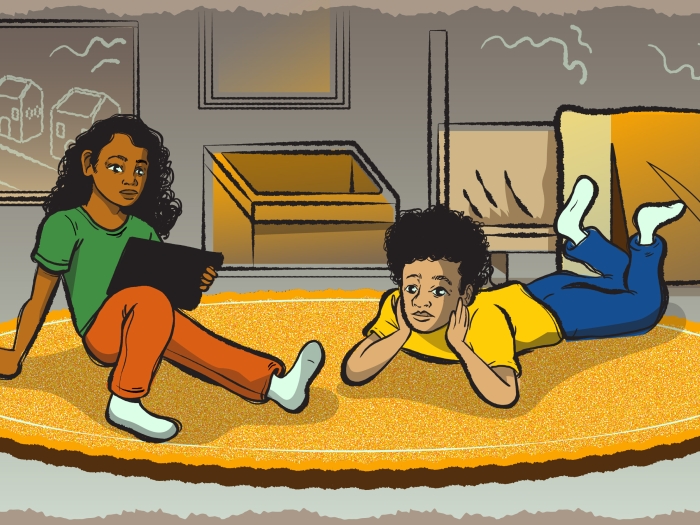Vaginal splinting, a tried-and-true method to relieve constipation without straining, went viral. A doctor explains the unorthodox method, and when to use it.
1:59 PM
Author |

A little-known way to relieve constipation without straining recently found fame on social media.
Chronicled in a TikTok video by a woman in the United Kingdom, "vaginal splinting" is poised to becoming the No. 1 technique to relieve No. 2.
Splinting involves inserting a clean finger into the vagina to push on the wall between the vagina and rectum, or the perineum. The push helps evacuate stool during a bowel movement.
It's estimated that up to 30% of women use this technique to occasionally help with bowel movements.
"Hook your thumb in your vagina," the TikTok user explains. "You can feel the poop and you can just (pop sound) it out. Let me know how it goes. You're welcome."
While the method may seem unorthodox, it's a valid way of easing constipation for some women, especially if you experience some sort of pelvic floor dysfunction, says Pamela Fairchild, M.D., an obstetric gynecologist at Von Voigtlander Women's Hospital who specializes in female pelvic medicine and reconstructive surgery.
Understanding the pelvic floor
The pelvic floor includes the muscles and tissue at the bottom – or floor – of the pelvis that support the bladder and the bowel. Both men and women have a pelvic floor but a woman's is larger to accommodate the birth canal.
Those who use splinting may have a vaginal prolapse, a condition where the walls of the vagina drop toward the vaginal opening. When the wall between the vagina and rectum bulges into the vagina, the prolapse is known as a rectocele. Rectoceles can be the result of pelvic floor injury sustained at childbirth, but they also occur in women who experience chronic straining, like being chronically constipated.
However, just because you are able to splint to help with bowel movements doesn't mean you have a rectocele.
In women with non-relaxing pelvic floors, splinting can help to overcome pelvic floor tightness and allow passage of stool when there is not a vaginal support issue. This most commonly happens with high tone pelvic floor dysfunction, which can be related to surgical history, chronic pain, or trauma history, but is often unexplained.
When muscles don't relax to allow passage of stool, treatment is aimed at muscle relaxation rather than correction of a rectocele.
In the end, every bowel movement should not be a struggle.Pamela Fairchild, M.D.
"You want your pelvic floor to have good resting tone, so your organs are well supported when you are walking around," Fairchild says. "A healthy pelvic floor then relaxes when it needs to relax, such as for bowel movements and urination, and tightens when it needs to tighten, like when you don't want to pass gas in an elevator."
The battle of the bulge
How do you know if a bulge is the cause of your constipation?
"If your stool is soft and formed, but still difficult to pass and you feel the bulge in the vagina when you try to poop, you may have a rectocele complicating your stool passage," says Fairchild, who is also co-director of the Michigan Bowel Control Program.
MORE FROM MICHIGAN: Sign up for our weekly newsletter
She often recommends splinting as a test to determine if a woman's rectocele is contributing to their constipation. It can help to determine if repair of a rectocele will help improve bowel function. This is because many women have small rectoceles that they don't notice and that do not play a role in bowel function or dysfunction.
If splinting the rectocele doesn't help passage of stool, then treatment aimed at repair of the rectocele is not likely to help passage of stool either.
"Splinting is safe to practice, unless you have broken skin or an irritation that make it painful to push on the vagina or perineal area," Fairchild says.
Even women with normal pelvic support still may get a bulge occasionally with constipation. The vagina is quite pliable to accommodate childbirth, Fairchild reminds.
"It's the path of least resistance, so if your rectum is full of stool, you will likely be able to feel that it is full by touching the wall between the vagina and rectum."
Treatment options for constipation
If you rely on splinting regularly, Fairchild recommends getting evaluated by a physician.
The first step would be to address the constipation, since creating soft stool will reduce strain while having a bowel movement:
-
Are you drinking enough water?
-
Getting enough fiber?
-
Exercising?
-
Going to the bathroom when the need arises?
-
Not postponing bowel movements?
Constipation can be caused by many conditions, but only some of these can be attributed to the pelvic floor. It's important to work with your health care provider to determine the cause.
If there is a problem with dysfunctional muscles, it can be best addressed with physical therapy, Fairchild says, and sometimes it means using a stepstool, like the Squatty Potty, while using the toilet.
If there is a true vaginal prolapse contributing to symptoms, physical therapy can help, and surgery to repair the rectocele may be an option. So can wearing a pessary, a small device placed inside the vagina to provide support to the pelvic floor.
"In the end, every bowel movement should not be a struggle," Fairchild says.
Like Podcasts? Add the Michigan Medicine News Break on iTunes, Google Podcast or anywhere you listen to podcasts.

Explore a variety of health care news & stories by visiting the Health Lab home page for more articles.

Department of Communication at Michigan Medicine
Want top health & research news weekly? Sign up for Health Lab’s newsletters today!





